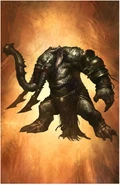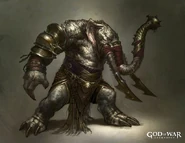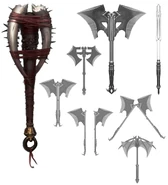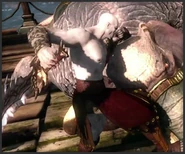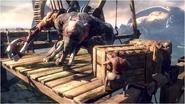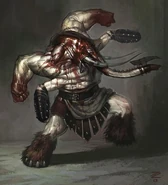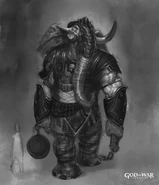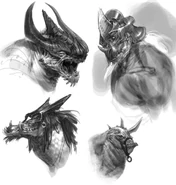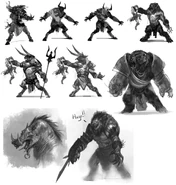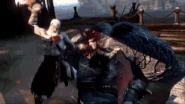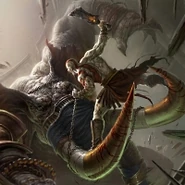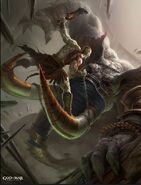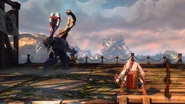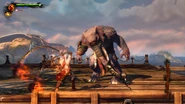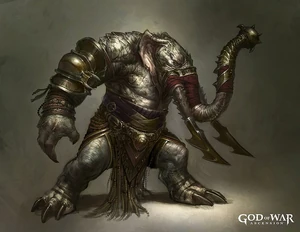
Juggernaut (formerly known as the Elephantaur) is an enemy that debuted in God of War: Ascension. It is not an actual beast from Greek mythology.
God of War: Ascension[]
Shaped like a fearsome and mighty elephant, its presence is similar to that made by the Minotaurs in previous installments of the God of War series. It moves on its hind legs and has its frontal paws shaped like human hands with claws to attack its preys. It also wears Persian armor that protects its arms, waist, tusks and even snout.
They were first featured as one of the new enemies in the game's demo (being also the enemy who introduced the promptless quick time event mechanic). In the actual game they're found for the first time in the Village of Kirra, and later in Delos Landing and the Shoulder of Apollo.
Juggernauts can attack by charging at Kratos to push him away with their tusks, by stomping on the ground with one of their feet to drive him back or by slashing at him with their claws, which is the only attack that can be blocked. Some of them also carry large maces made with spiked elephant tusks and can swing or slam them against the ground and Kratos. In the campaign, only the Juggernaut of Delos Landing is found carrying one of these maces, and also the one seen in the demo. After taking enough damage, the Juggernaut will destroy its weapon by slamming it against the ground, which can damage Kratos if he's near. After losing its weapon, the beast will attack him normally, with its bare hands. Usually, it tries to charge at him right after destroying the mace.
Juggernauts can also try to grab Kratos if they're attacking with their bare hands. If the Spartan doesn't evade the attack, the Juggernaut will grab and hold him up with one hand, fiercely squeezing and harming him. However, Kratos' arms aren't restrained, and he can still attack with his Blades. Thus, he must stab the beast's hand repeatedly until it releases him in pain, and then he will latch the Blades on the Juggernaut's back and pull it down to slam it against the ground.
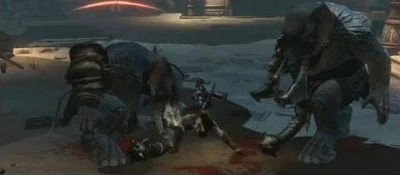
Two Juggernauts in Kirra
If a Juggernaut is stunned (golden halo on its head), Kratos can climb it and stab its backs to make it charge and collide against other enemies, which knocks many of them away. After the charge, he will stab the beast one last time to make it fall on the ground, after which he will dismount from it. If Circle is pressed while Kratos rides the Juggernaut, he will stab and dismount from it instantly. The Spartan can finish it by climbing its tusks and stabbing its head to bring the whole beast down to the floor. He will then stab its head repeatedly while trying to avoid being grabbed and thrown away by it in a promptless quick time event, and finally nail his Blade into its skull one last time and use it to tear it down, creating a large hole that reveals its brain. Killing a Juggernaut this way yields Kratos both red and green orbs.
Death scene: If Kratos runs out of health when a Juggernaut is squeezing him in its hand, it will strongly press him one last time, throw him to the floor and step on him with one of its huge feet, killing him. However, the screen fades to black before it can actually be seen stomping on Kratos.
Multiplayer: Juggernauts can be found in Trial of the Gods in the Desert of Lost Souls, the Coliseum of Persia and the Labyrinth of Daedalus maps. The Labyrinth is the map with the biggest number of Juggernauts, with three of them, whereas there's only one in the Desert and another one in the Coliseum. A Juggernaut kill is worth 50 favors (70 if it's a brutal kill) and +25 seconds.
All Juggernauts of Multiplayer spawn with maces, and similar tactics must be used against them. However, almost none of their attacks can be blocked here. If stunned, players will stab their backs to ride them around the same way Kratos does, and this yields them extra favors. The brutal kill remains the same as well, although the promptless quick time event is removed, and players don't need to stab their heads many times before tearing them open.
Trivia[]
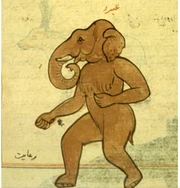
An elephant-headed Nasna depicted in Muḥammad al-Qazwīnī's “Marvels of Things Created and Miraculous Aspects of Things Existing.”
The Juggernaut might actually be a Nasna, which is a Jinn-like creature from Islamic/Arabian mythology. Nasnas come in many forms, commonly that of a human with the head of an animal. An elephant-headed Nasna is depicted in the book "Marvels of Things Created and Miraculous Aspects of Things Existing” written by Muḥammad al-Qazwīnī which is a collection of Middle Eastern spirits known to Islamic and Arabian folklore. Considering an Ifrit has appeared in the franchise, which is also a type of Jinn-like spirit from Islamic beliefs, it is safe to say that the Juggarnaut is indeed a Nasna.
- The Juggernaut is also heavily inspired by Hindu mythology. Its form appears to have been based on the elephant headed Hindu god Ganesha, also known as Ganesh, who is revered as being “the remover of obstacles” something which Kratos can be seen as given his opposition to Ares plans. Meanwhile, the word Juggernaut is itself an Anglicization of the Sanskrit name Jagannātha meaning “lord of the world” an alternative name for the major Hindu god Krishna, the god of protection and preservation. It has since come to mean something unstoppable in English which is extremely appropriate as two of Krishna’s epithets are Aniruddha (He who cannot be obstructed) and Akṣarā (He who is indestructible).
- The Juggernaut was planned to appear in God of War III and was named the Berserker. Several crew members were disappointed that it didn't make it into the game.
- Other ideas for this enemy were a redesigned version of the Minotaur, as they looked into many dangerous and aggressive animals like bears, crocodiles, hyenas, boars, and rhinos.
- The rhinotaur was quickly abandoned as it looked 'too Disney'.
- An idea of the dragotaur, an anthropomorphic dragon-like version of the Minotaur, was also included but this too was abandoned.
- Since this creature shows some Persian elements in it, this may possibly be a revised version of the War Elephant that was cut in God of War: Chains of Olympus. However, this remains unconfirmed.
- The name "Elephantaur" means it should be a cross between an elephant and a bull (tauros), rather than a man.
- The blades placed at the tips of the Juggernaut's tusks greatly resemble the Blades of Chaos if looked up closely.

